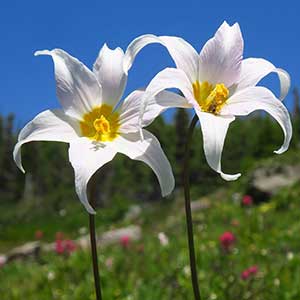Erythronium quinaultense
Erythronium montanum
fawnlily, Olympic fawn-lily, quinault fawn-lily, quinault trout-lily
avalanche-lily, white avalanche-lily, white glacier lily
narrowly ovoid, 35–75 mm.
narrowly ovoid, 25–60 mm.
12–20 cm;
blade green or faintly mottled with white or brown, lanceolate to ovate, margins ± wavy.
10–20 cm;
blade green, ovate to broadly lanceolate, base ± abruptly narrowed to petiole, margins wavy.
12–25 cm.
12–35 cm.
1–3-flowered.
1–3-flowered.
tepals white proximally, shading to pink at outer margins, darkest toward tips, with yellow band at base, lanceolate to narrowly ovate, 30–50 mm, inner with small auricles at base;
stamens 12–24 mm;
filaments white, flattened, slightly widened, linear to lanceolate, 1–2 mm wide;
anthers yellow;
style white, 10–18 mm;
stigma with slender, usually recurved lobes 1–5 mm.
tepals white to creamy white with bright yellow zone at base, broadly ovate to broadly lanceolate, 25–45 mm, inner wider than outer, auriculate at base, length less than 4 times width;
stamens 12–24 mm;
filaments white, linear, slender, less than 0.8 mm wide;
anthers bright yellow;
style white, 13–25 mm;
stigma with slender, usually recurved lobes 1–5 mm.
oblong to obovoid, 3–6 cm.
oblong, 3–6 cm.
= 48.
= 24.
Erythronium quinaultense
Erythronium montanum
Erythronium quinaultense is a tetraploid species apparently derived from hybridization between E. montanum and E. revolutum. It is known only from the southwestern Olympic Peninsula.
(Discussion copyrighted by Flora of North America; reprinted with permission.)
This species occurs in the Coast Ranges of southern British Columbia, and disjunctly to southern Vancouver Island, the Olympic Peninsula, and Cascade Mountains from Mount Rainier National Park in Washington to central Oregon.
(Discussion copyrighted by Flora of North America; reprinted with permission.)


